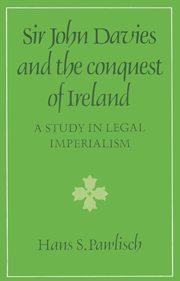Book contents
- Frontmatter
- Contents
- Preface
- Abbreviations
- PART I INTRODUCTION
- PART II JUDICIAL ENCOUNTERS: THE NATIVE COMMUNITY
- 4 The cases of gavelkind and tanistry: legal imperialism in Ireland, 1603–1610
- 5 The case of the Bann fishery
- PART III JUDICIAL ENCOUNTERS: THE COLONIAL COMMUNITY
- PART IV CONCLUSION
- Notes
- Select bibliography
- Index
- Cambridge Studies in the History and Theory of Politics
5 - The case of the Bann fishery
from PART II - JUDICIAL ENCOUNTERS: THE NATIVE COMMUNITY
Published online by Cambridge University Press: 13 October 2009
- Frontmatter
- Contents
- Preface
- Abbreviations
- PART I INTRODUCTION
- PART II JUDICIAL ENCOUNTERS: THE NATIVE COMMUNITY
- 4 The cases of gavelkind and tanistry: legal imperialism in Ireland, 1603–1610
- 5 The case of the Bann fishery
- PART III JUDICIAL ENCOUNTERS: THE COLONIAL COMMUNITY
- PART IV CONCLUSION
- Notes
- Select bibliography
- Index
- Cambridge Studies in the History and Theory of Politics
Summary
Gaelic patterns of landholding at the beginning of the seventeenth century constituted a barrier to the exercise of effective English sovereignty in Ireland. The Tudor conquest, however, enabled the government to eliminate tribal patterns of descent and partible inheritance by judicial resolution, thus extending English law throughout the island. Judge-made law likewise served as the tool for establishing English tenures throughout the former autonomous Gaelic lordships. This new departure launched by the proclamation of denization in March 1605 resulted in a series of investigations into patterns of landholding in Ulster that reduced significantly the large tracts of land allocated to the Gaelic leadership by the settlement made at Hampton Court during August 1603. The government concentrated this campaign against the earls of Tyrone and Tyrconnell, and Davies' Reports also record its efforts to disrupt the estates of Sir Randall MacDonnell.
Like the northern earls, this renegade Scottish chieftain fared well in the land settlement of 1603, repossessing much of his family's traditional estate comprising the territories known as the Rout and the Glens in the present county of Antrim, running along the coast from Larne to Coleraine. This grant, exceeding 300,000 acres, owed much to the personal influence of the new Scottish king, James I, as well as to the personal acumen of Sir Randall himself. James VI of Scotland had openly supported the MacDonnells during the Nine Years War in their rebellion against the English government.
- Type
- Chapter
- Information
- Sir John Davies and the Conquest of IrelandA Study in Legal Imperialism, pp. 84 - 100Publisher: Cambridge University PressPrint publication year: 1985



